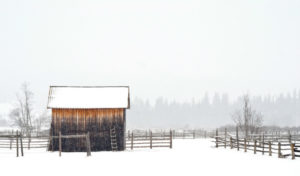Winter weather will strike before you know it. Now is the time to prep your farm or homestead for the elements that beat against it all winter long. Fortunately, there are some simple ways to prep for winter and start weatherproofing your property that doesn’t take a lot of time or money.
The cost of heating with natural gas increased by 22 percent in 2017. While these costs vary, depending upon supply and demand, anything you can do to make your home more energy efficient puts money in your pocket and allows you to use that money for other projects — or even toward investing in a system that will enable you to go entirely off the grid. Here are seven tips to follow to weatherproof your property before winter hits.

1. Inspect Your Roof
One of your first tasks toward weatherproofing your home this winter should include inspecting your roof. This is also an appropriate time to check the roofing on any barns or outbuildings. Check for any loose or damaged shingles and replace them. Look over chimney pots and aerials to ensure they are attached and sealed correctly.
2. Check Your Gutters
Debris such as falling leaves tends to clog gutters. This becomes a serious problem in the winter as the melting snow water backs up onto the roof and freezes. The result might be leaks or buckling of your roof. A quick inspection of gutters and removal of any debris can save you thousands in costly repair or replacement bills and is simple enough for even an amateur to complete.
3. Prevent Damage to Stone or Brick
Outdoor stone, brick and concrete are vulnerable to damage from the elements because they are porous materials. Keep an eye out for efflorescence, which can be indicative of a more significant problem — moisture can be wicked up to six miles and threaten the entire structure. You’ll see this problem as a shine to the surface or a sort of floral-looking pattern. To prevent the damage from salt and even water getting into cracks and then expanding during freezing weather, seal all porous surfaces and check for cracks in mortar and concrete.
4. Seal Air Leaks
Stopping warm air from escaping your home saves on utility costs and is a straightforward fix. Something as easy as installing weather stripping helps prevent indoor air from escaping outdoors. Check the caulking around your windows and doors, as well. If you don’t have double pane windows or feel a lot of air is escaping, consider a simple fix, such as plastic insulation that covers the window for the season or insulated drapes.
5. Clean the Garden
Before winter hits is the best time to clean up your gardens and remove any debris or leaves that have fallen. This also helps prevent your plants from developing several diseases. Prune shrubs and cover any plants that need to be covered. Check with your local garden center if you’re not sure, as some plants require additional mulch at the base, some require very little maintenance and others need to be covered for the harsh weather.
6. Insulate Pipes
If you have pipes that reside in a crawl space, take the time to wrap them with insulation. If the power goes out or it gets particularly cold in your crawl space, you’ll give yourself a buffer against freezing and busting pipes, which can create additional damage and issues that cost a bundle to fix.
7. Cover Outdoor Spigots
Take the time to remove all garden hoses and store them for the winter, or switch to one that retracts automatically and allows you to disconnect it after each use. Buy insulated covers for outdoor spigots to protect them from freezing weather. Styrofoam spigot covers run $3 or less and defend your spigots from winter weather.
Weatherproofing Protects Your Investment
Spending a little time in the fall weatherproofing your home saves you money in the long run. The most significant investment with the seven tips listed above is your time. The payoffs in savings and preventative maintenance are worth thousands.











1 Comment
any tips on how to prevent ice build up on roof edges ???